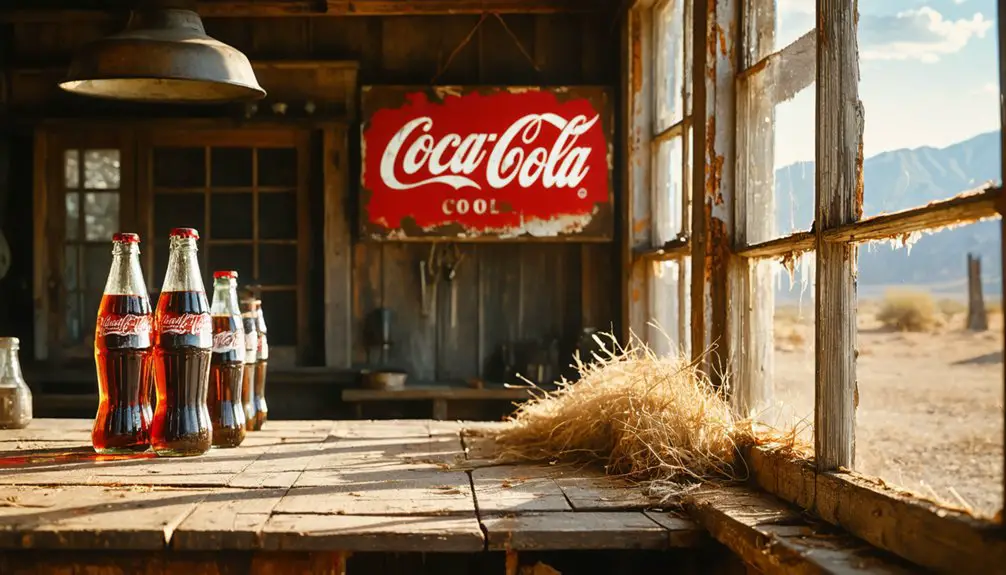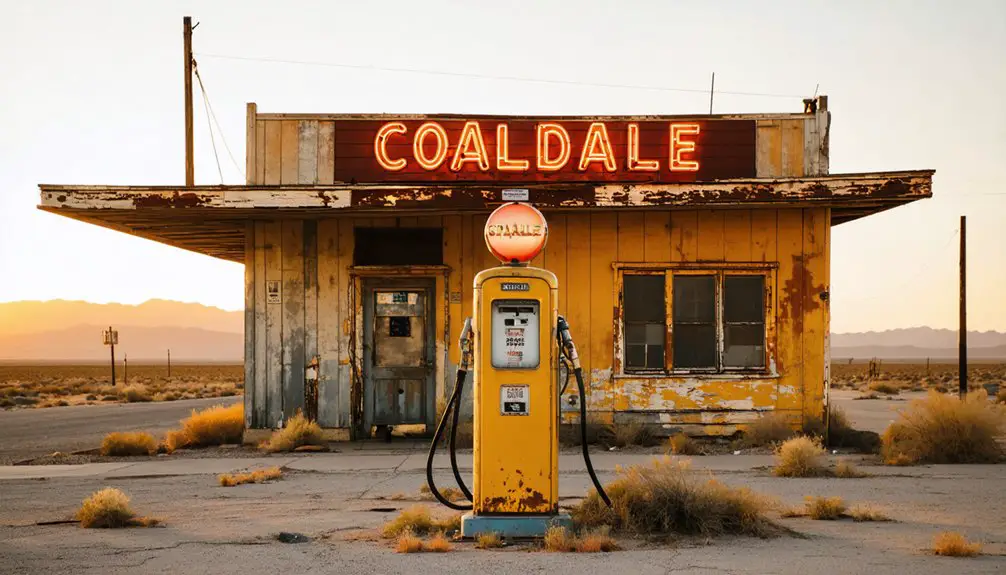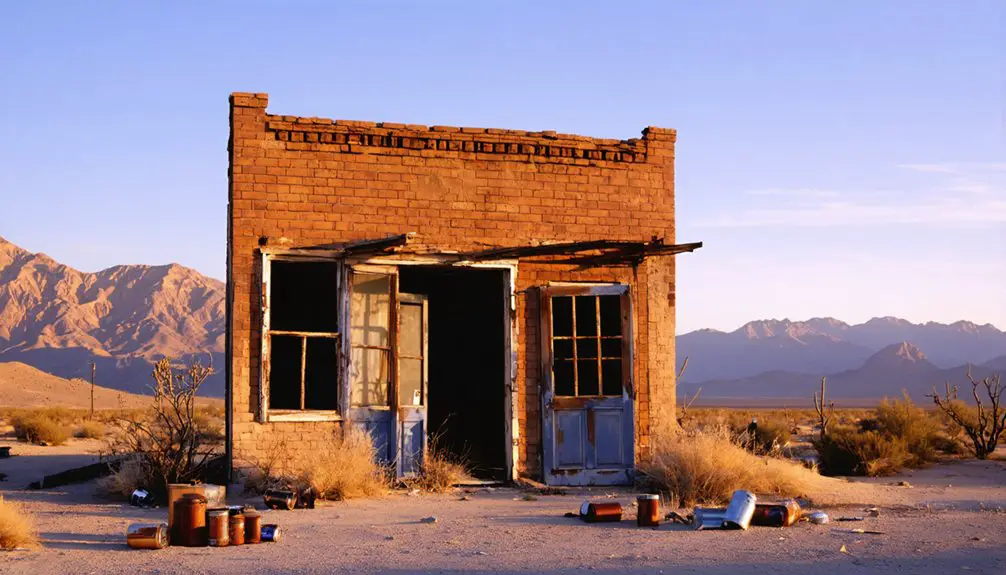You’ll discover Coaldale at the junction of US Routes 6 and 95 in Nevada, where coal mining operations from the 1880s later gave way to a thriving desert rest stop. The town evolved from mining roots into a mid-century traveler’s oasis with a motel, casino, and gas station. In 1993, leaking underground fuel tanks forced sudden abandonment, leaving behind intact buildings and artifacts that reveal layers of Western boom-and-bust history.
Key Takeaways
- Coaldale, Nevada became a ghost town in 1993 after EPA testing revealed toxic fuel leaks, forcing closure of all businesses.
- Originally established as a coal mining town in the 1880s, Coaldale later thrived as a highway stop at US Routes 6 and 95.
- The town’s final population reached fifty residents before environmental contamination led to complete abandonment.
- Abandoned buildings include a motel, restaurant-casino, general store, and gas station, largely untouched since 1993.
- The site gained brief fame as a filming location for “The Stranger” in 1994 and now attracts urban explorers.
From Mining Boomtown to Desert Rest Stop
When William Groetzinger discovered coal near Nevada’s Silver Peak Range in the 1880s, he set in motion Coaldale’s transformation from empty desert to bustling mining town.
Early mining yielded 150 tons of coal for a local borax factory, sparking interest from investors like Louis K. Koontz, who poured $50,000 into development. Despite setbacks from poor coal quality, a 1911 USGS survey reignited mining prospects, leading to new operations by Nevada Coal and Fuel Company.
After initial coal discoveries sparked investor interest, poor quality threatened operations until a 1911 survey revived mining prospects.
As coal mining declined after 1946, you’ll find Coaldale reinvented itself as an essential transportation hub at the crossroads of US Routes 6 and 95. The Tonopah and Goldfield Railroad provided crucial transportation links for the area.
The town’s mining history gave way to traveler services – a 12-room motel, restaurant-bar-casino, general store, and gas station became the new economic drivers for this desert outpost. The town reached its peak of fifty residents during this period of transition.
The Final Days of Fuel and Fortune
You’ll find the turning point of Coaldale’s demise in 1993, when EPA testing exposed leaking underground fuel tanks at the town’s last remaining gas station.
The environmental crisis forced the closure of not just the fuel stop, but also triggered the shutdown of the adjacent restaurant and motel – the final businesses keeping this desert outpost alive.
After years of decline starting with the coal mines closing in the late 1940s, the town’s fate was sealed.
Environmental Crisis Strikes
The 1993 EPA inspections at Coaldale’s gas station revealed a devastating environmental crisis that would seal the town’s fate. The discovery of leaking underground fuel tanks violated new environmental regulations, forcing an immediate shutdown of the station.
You can still see the impact of this crisis through:
- Abandoned fuel tanks that once contaminated the desert ecosystem
- The vacant gas station that served as the town’s economic lifeline
- The deteriorating buildings left behind when residents fled
Without the means to upgrade their tanks or afford the cleanup, Coaldale’s businesses collapsed like dominoes. The town’s Highway 95 and 6 junction location couldn’t save it from complete abandonment. Modern travelers can explore this site during their seven to eight hour drive through Nevada.
The restaurant and motel, dependent on highway travelers stopping for fuel, quickly followed suit. This environmental catastrophe triggered the final wave of town abandonment, transforming a once-bustling desert stop into the haunting ghost town you’ll find today.
Last Gas Stop Standing
For nearly half a century, Coaldale’s gas station stood as an essential lifeline at the crossroads of US Routes 6 and 95, marking one of the last bastions of civilization along this desolate stretch of Nevada highway.
You’d find Eldon and Jewel Parsons there, running the station since the 1940s, keeping the spirit of community resilience alive after the mines closed down. After her divorce, Jewel managed alone, demonstrating the same grit that defined the town’s character throughout its history.
The gas station nostalgia runs deep – it wasn’t just a fuel stop, but the town’s economic anchor. Alongside the motel and restaurant, it drew travelers who needed that critical fill-up in the vast Nevada desert. Today, the property sits abandoned with polluted soil beneath the old station, a stark reminder of its petroleum past.
The station’s presence preserved Coaldale’s identity, transforming it from a former mining town into an essential highway pitstop, until environmental concerns forced its closure in 1993.
Economic Lifeline Severed
Deep beneath Coaldale’s economic struggles lay a complex web of interconnected failures that ultimately sealed the town’s fate. The community’s resilience shone through their economic adaptation from coal mining to roadside services, but even this transformation couldn’t save them. The area’s rich deposits of uranium and turquoise remained largely untapped as the town declined.
- By 1946, Herman Darms’ death marked the end of coal operations, forcing the town to rely entirely on highway travelers.
- The closure of the Tonopah and Goldfield Railroad cut off essential transportation arteries.
- The gas station, motel, and restaurant – your last bastions of commerce – eventually shuttered their doors.
You’ll find that Coaldale’s story mirrors many Western towns that couldn’t overcome the perfect storm of resource depletion, infrastructure loss, and changing travel patterns.
The town’s final economic lifeline was severed when these roadside services closed, leaving only empty buildings as evidence of its struggle for survival.
Environmental Crisis and Economic Collapse
You’ll find evidence of Coaldale’s final downfall in the rusted remnants of underground fuel tanks that leaked toxic substances into the soil in 1993.
The EPA’s discovery of this contamination forced the immediate closure of the town’s lifeline – its gas station.
This environmental catastrophe triggered a domino effect, causing the motel and restaurant to shut down shortly after, effectively sealing the town’s fate as Nevada’s newest ghost town.
Toxic Tanks Take Toll
In 1993, when the Environmental Protection Agency mandated nationwide upgrades to underground fuel storage tanks, Coaldale’s primary economic lifeline began to unravel.
You can still see the remnants of the once-bustling gas station where tank leaks released toxic fuel into the soil, forcing its permanent closure under environmental regulations.
The impact was swift and devastating:
- Contaminated soil rendered the town site hazardous, with benzene and toluene threatening regional groundwater.
- Without passing traffic, the town’s motels and restaurants quickly succumbed to economic despair.
- Property values plummeted as environmental liabilities deterred any chance of redevelopment.
The cleanup costs could have exceeded $200,000, with BTEX compounds being the main contaminants of concern due to their serious health risks.
Today, you’ll find abandoned buildings and equipment, silent witnesses to how a small town’s fate hinged on aging underground tanks that poisoned both its soil and its future.
Recent community engagement efforts have sought to gather local input on potential restoration strategies, though progress remains challenging.
Last Business Falls Silent
One by one, Coaldale’s remaining businesses shuttered their doors after the gas station’s forced closure in 1993.
The town’s business legacy crumbled as the restaurant and motel, dependent on passing travelers, couldn’t sustain operations without the anchor gas station drawing customers.
The community impact was swift and devastating.
You can still see evidence of the hurried exodus – kitchen equipment left mid-service in the restaurant, partially mowed lawns, and abandoned furniture in the motel rooms.
The once-busy airstrip fell out of code, cutting off yet another lifeline to the outside world.
What you’re witnessing today is the result of that rapid economic collapse: empty buildings that once housed thriving businesses, now serving as silent monuments to a community that dissolved almost overnight.
A Time Capsule in the Nevada Desert

Standing frozen in time since its sudden abandonment in 1993, Coaldale presents visitors with an eerie glimpse into Nevada’s desert town life.
You’ll find the skeletal remains of a once-bustling roadside community, where empty buildings stand as silent sentinels to the town’s abrupt end. For urban exploration enthusiasts and historical preservation advocates, Coaldale offers a rare, undisturbed look at mid-20th century desert living.
- The motel, restaurant, and gas station remain largely intact, complete with discarded furnishings.
- The town’s original layout, including the central park area and plotted streets, is still visible.
- Abandoned structures serve as a stark indication of the vulnerability of single-industry towns.
Today, you’re free to explore this desert time capsule, where every weathered building tells a story of boom, survival, and ultimate decline.
Notable Structures and Physical Layout
The physical remnants of Coaldale tell a compelling story through their strategic placement and architectural details.
You’ll find this roadside community positioned at the junction of U.S. Highways 6 and 95, where mid-20th century buildings huddle close to the thoroughfare. The motel, store, gas station, and restaurant showcase distinctive architectural features like wood-framed structures layered with stucco finishes and period-specific interior elements.
Time-worn buildings cluster at the desert crossroads, their stucco walls and vintage details marking Coaldale’s place in mid-century highway history.
You can trace the town’s evolution through its buildings, from the avocado-colored shower stalls to the varied wood additions that mark different construction periods.
While time and desert conditions have taken their toll, leaving graffiti-marked walls and rust-covered artifacts, these structures stand as silent witnesses to Coaldale’s heyday as an essential highway stop in the Nevada desert.
Legacy in Film and Historical Documentation

While largely forgotten today, Coaldale gained fleeting fame as the filming location for the 1994 cult biker film “The Stranger,” starring kickboxing champion Kathy Long.
The production briefly transformed this Nevada ghost town, bringing a surge of activity as crews reconstructed parts of the settlement for the leather-clad heroine’s fight against killer bikers.
Here’s what makes Coaldale’s film legacy particularly intriguing:
- The movie’s production marked the town’s busiest period in recent history
- Film sets were dismantled after completion, adding to the cultural decay
- The town now exists mainly in biker film nostalgia and YouTube exploration videos
Today, you’ll find Coaldale documented through local news articles, urban explorer footage, and historical records that capture its evolution from movie set to graffiti-covered ruins, symbolizing both cinematic heritage and small-town abandonment.
Frequently Asked Questions
Is It Legal to Visit and Explore Coaldale’s Abandoned Buildings?
Where there’s smoke, there’s fire. You can’t legally explore Coaldale’s buildings without permission – exploration laws and ghost town regulations require owner consent. Stick to photographing from public roads.
Are There Any Paranormal Activity Reports From the Ghost Town?
You won’t find documented ghost sightings or haunted legends here. While visitors report feeling uneasy in the abandoned buildings, there’s no official evidence of paranormal activity among the deteriorating structures.
What Happened to the Residents Who Left Coaldale?
You’d find former residents scattered across Nevada, like John Miller who moved to Tonopah for work. Most ghost town history shows they left seeking jobs, heading to nearby cities or beyond.
Does Anyone Still Own the Property Rights to Coaldale?
Yes, Ed Ylst’s trust currently holds Coaldale’s property ownership rights. You’ll find the historical site’s been listed for sale multiple times since 2006, but it hasn’t successfully changed hands.
Are There Plans to Preserve or Restore Any Coaldale Structures?
You won’t find active preservation efforts currently underway. Environmental contamination and fire damage present major restoration challenges, while the town’s private ownership hasn’t announced any formal rebuilding plans.
References
- https://abandonedin360.com/abandoned-government-properties/coaldale/
- https://www.abandonedspaces.com/towns/coaldale-nevada.html
- https://eponaleah.wordpress.com/2012/01/12/coaldale-nevada-the-ambition-of-a-prospector-in-petticoats/
- https://kids.kiddle.co/Coaldale
- https://www.loc.gov/pictures/item/2023697072/
- http://freepages.rootsweb.com/~gtusa/history/ontheroad/us6b.htm
- https://www.nevadaappeal.com/news/2014/feb/14/tiny-nevada-town-of-coaldale-for-sale-again/
- https://pubs.usgs.gov/bul/0531k/report.pdf
- http://epubs.nsla.nv.gov/statepubs/epubs/210988-2020.pdf
- https://ronhess.info/docs/report7_history.pdf



